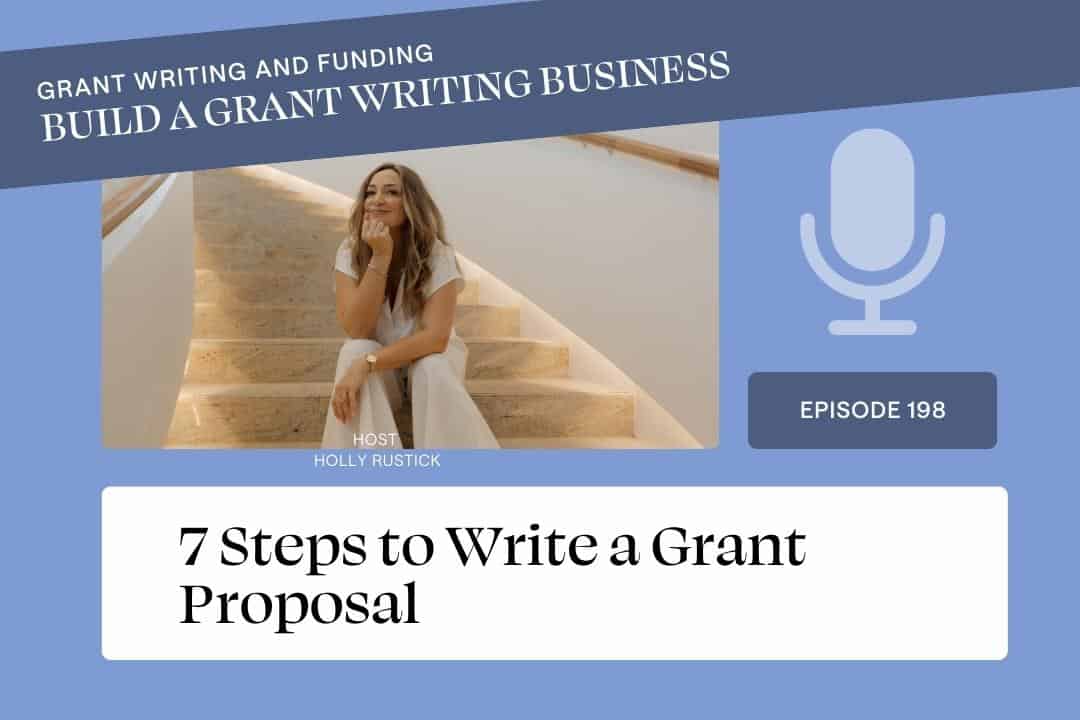7 Steps to Write a Grant Proposal

December 8, 2021
Writing grant proposals can feel overwhelming, defeating, and just plain stressful. However, it doesn’t need to feel that way when writing a grant proposal.
When you understand the basic grant writing structure, then you start to:
- Put grants together more quickly
- Feel more confident when starting the grant writing process
- Start to see your grant award success rate improve
However, you need to know what the basic framework of a grant application is!
No running for the hills. I got you ;)
Follow these simple steps to write a grant and you will immediately eliminate overwhelm, defeat, and stress!
Step #1 Grant Proposal Process – Get the FOA/RFP
Is your nonprofit even eligible for a grant application? This may sound a little basic, but many people start writing a grant without reading the Funding Opportunity Announcement or Request for Proposal.
Yep. Then they gloss over:
- potential required deadlines have passed,
- formatting requirements, and
- mandated attachments
Without knowing these important requirements, they may not even be eligible. Then they may spend 60 hours on a grant and really end in a declined grant application.
Step #2 Grant Proposal Process – Research the Needs and Design a Problem Statement
Without a compelling problem statement, your grant application may be denied.
Remember, you need to include some of the following to demonstrate the need:
- Statistics
- Case Studies
- Surveys
- Testimonials
- Research
- and more
For your problem statement, you need to include:
- What the specific need is
- Why it’s a problem
- Be specific
For example, you demonstrate the need by doing research and find out there are hundreds of stray animals in your city. These stray animals are malnourished and packs are forming. Additionally, there are no vehicles and workers in your area to pick up stray animals.
So your problem statement could be, “There are no vehicles or people to round up stray animal in X city.”
Step #3 Grant Proposal Process – Articulate the Goal
Now that you understand what the problem statement is, you can now write your goal.
To understand what a goal would be, answer the following question: What is the overarching result that you want from the program your nonprofit develops?
One goal might be: “To reduce the number of stray animals in x city to create healthier animals and spaces.”
This is pretty big and overarching, but it’s what the ultimate result you are wanting to achieve.
Step #4 Grant Proposal Process – Narrow the Objectives
Now that you understand the ultimate end-result (i.e., goal), you have to create a pathway to reach that goal.
Objectives are what can help you reach your goal.
They need to be SMART:
- Specific
- Measurable
- Achievable
- Relevant/Realistic
- Time-bound
For our example, one objective might be: “To purchase two vans and hire four employees by the end of the year.”
Step #5 Grant Proposal Process – Timeline Your Activities/Tasks
Now that you have your objective, how are you going to ensure that it is reached? By creating a timeline of all activities!
Example Task 1: “The executive director will purchase two vans by the end of month two.”
Example Task 2: “The executive director will hire four employees by the end of month three.”
This shows clear timelines for each activity needed to complete the objective.
Step #6 Grant Proposal Process – Strategic Budget
Create a strategic budget that includes every element from your objectives! Don’t forget anything in your budget that is in your grant application.
The strategic budget would need to include:
- Funding for purchasing the vans (plus, maintenance, fuel, registration, etc.)
- Funding for hiring the employees
- Any other funding for the project
Step #7 Grant Proposal Process – Submit Early
Remember, it is so important to not have the grant application deadline YOUR deadline.
Pick a couple of days before (at the very least) to be your deadline.
Always give yourself some time as tech craziness can happen, letters of support can come in late, and wrong deadline times can be written down.
If you want to join more than 1,000 students who have completed a step-by-step process on how to write grants, take our free grant writing class by clicking here.
Holly Rustick
Meet the author Holly Rustick
Work with Me
Write Grants, Get Paid.
Freelance Grant Writer Academy
Grant Professional Mentorship
JOIN OUR NEWSLETTER
Holly Rustick is a world-renowned grant writing expert and Amazon bestselling author.
Holly has been coaching grant writers how to run successful 5-6 figure businesses since 2017.
With two decades of grant writing and nonprofit experience, Holly is a popular keynote speaker for events all over the world, podcast host of the Top-Ranked Grant Writing podcast, a former university instructor, and is past president of the Guam Women’s Chamber of Commerce. She is constantly booked out to run trainings to help grant writers grow capacity, increase funding, and advance mission.
Love this post? You'll love these resources.
GET ACCESS NOW
Free Grant Writing Class
Get the proven 7 steps to eliminate anxiety and get Holly’s 20 years of secrets to start writing winning grants.
You will get the grant writing system that has helped Holly secure more than $25 million in grant funding and students earn more than $100,000,000 in funding for nonprofits around the world!
GET ACCESS NOW
Free 5-Step Checklist
OUR SPICY BELIEF IS THAT ALL GRANT WRITERS SHOULD START A BUSINESS, EVEN IF IT’S PART-TIME.
Work from home and have a massive impact on your community. Set up a grant writing business so you can start getting paid to write grants.